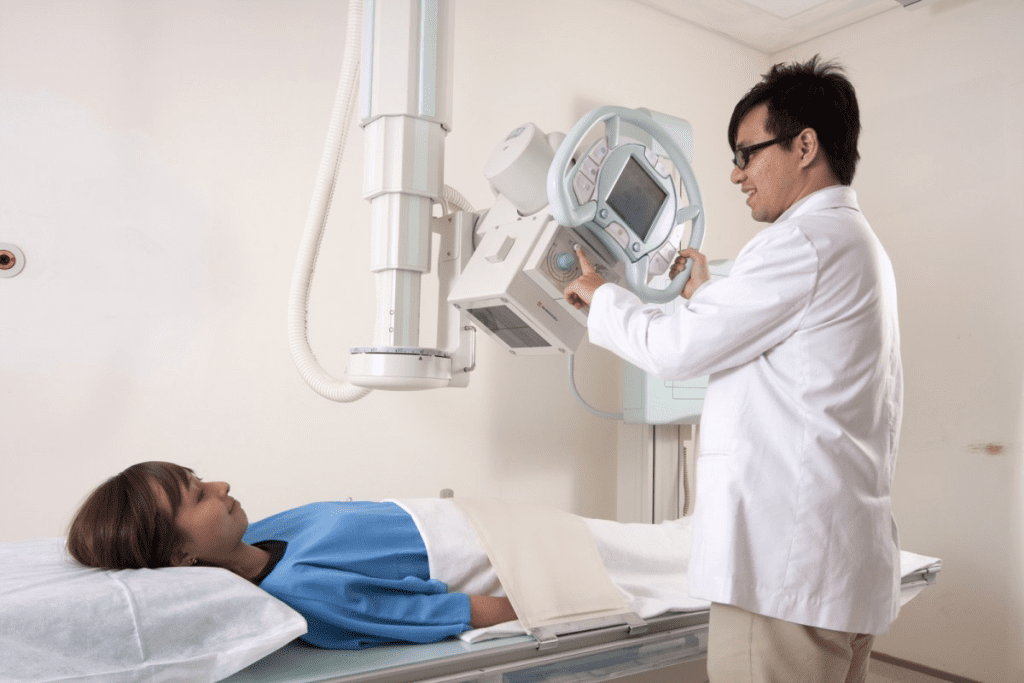Last Updated on November 25, 2025 by

Knowing how long a CT urogram test takes can help ease worries about medical tests. At Liv Hospital, we use the latest imaging tech. This ensures our patients get accurate diagnoses with little discomfort.
A urogram CT is a detailed tool for checking the urinary system. The test’s length depends on the case’s complexity and the imaging needs.
We’ll walk you through what happens during a ct urography test. This includes getting ready, the scan itself, and aftercare. Our aim is to fully explain the ct urogram duration and its importance in diagnosis.
A urogram test, also known as urography, is a way to see the urinary system. It helps find problems in the urinary tract.
Urography uses imaging to show the urinary system’s details. This includes the kidneys, ureters, and bladder. CT urography is a top-notch version that uses CT scans for clear images.
There are a few types of urography:
Each type has its own uses. For example, CT urography is great for spotting stones, tumors, and other issues in the urinary tract.
Urography is key in finding the cause of hematuria, or blood in the urine. It can reveal kidney stones, infections, and tumors. Urography gives doctors a clear view of the urinary tract to find the source of blood in the urine.
Urography also helps find other urinary problems, like:
Urography is important because it finds problems in the urinary tract. It can spot issues in up to 22% of young adults with hematuria. Finding problems early is key to better treatment and outcomes.
A study found that CT urography is a top tool for checking patients with hematuria. It’s very good at finding urinary tract problems.
“The use of CT urography has revolutionized the diagnosis of urinary tract disorders, providing unparalleled detail and accuracy.”
Understanding urography helps us see its importance in managing urinary issues and finding problems.
Knowing how long a CT urogram takes is key for those getting ready for it. We’ll cover the typical time needed, what each part of the process involves, and things that might change the total time.
A CT urogram usually lasts about 35 to 40 minutes. This includes getting ready, the scan itself, and any extra steps for a full diagnosis. The CT urogram duration is quite quick, making it a great tool for checking on the kidneys and urinary system.

The CT urogram has several parts, each taking a different amount of time:
Adding these parts together usually means the whole ct urogram procedure time is 35 to 40 minutes. But, the exact time can change a bit based on the patient.
Even though the usual ct urogram duration is 35 to 40 minutes, some things can make it longer:
Our medical team is ready for any changes in the procedure. We aim to make the diagnostic process as smooth and quick as possible.
The preparation phase is key to a successful urogram test. We’re here to guide you through it. Proper preparation ensures the test’s accuracy and minimizes complications.

Preparing for a urogram test includes following fasting rules. Patients usually fast for a set time before the test. The exact time depends on your healthcare provider’s instructions. Fasting reduces risks and ensures accurate test results.
Staying hydrated is crucial for your urogram test prep. Drink lots of water before the test to keep your urinary system hydrated. This improves image quality. But always follow your healthcare provider’s hydration instructions, as they may vary based on your health.
Some medications might need to be adjusted or stopped before the test. Tell your healthcare provider about all medications you’re taking, including supplements and over-the-counter drugs. They’ll guide you on necessary adjustments for your safety and accurate results.
By following these guidelines, you ensure a smooth urogram test. If you have questions or concerns, contact your healthcare provider for help.
The CT urogram process has several key steps for accurate diagnosis. Knowing these steps helps patients prepare and understand what to expect.
When you arrive, you’ll check in and get assessed. This step checks your information, reviews your medical history, and prepares you for the test. “The initial assessment is a critical step to ensure patient safety and the success of the CT urogram,” says Dr. John Smith, a radiologist with over 10 years of experience.
The next step is getting the contrast material through an intravenous (IV) line. This contrast agent makes the urinary tract structures stand out in the images. Proper administration of contrast is crucial for obtaining clear images.
After getting the contrast, there’s a waiting period. This lets the contrast spread through the urinary system. It’s key to getting high-quality images.
The excretory phase imaging starts about three minutes after getting the contrast. Images are taken as the contrast passes through the urinary tract. This phase provides valuable information about the functioning of the urinary system.
Dr. Jane Doe says, “The excretory phase is especially important for spotting issues like kidney stones or tumors in the urinary tract.” The whole CT urogram process, from start to finish, usually takes 45-60 minutes. This time can vary based on the case and the test’s specific needs.
After a CT Urogram, patients start a recovery period. This time is key for a smooth and safe healing. It’s important to follow the right steps during this phase.
Right after the CT Urogram, patients are watched closely. This is to see if they react badly to the dye used. The monitoring period is usually 15 to 30 minutes. During this time, their vital signs are checked often.
Hydration is crucial after a CT Urogram. Drinking lots of water helps get rid of the dye. Patients should drink at least 8 to 10 glasses of water in 24 hours. Unless told otherwise by a doctor.
Most people can go back to their normal activities soon after. Unless a doctor tells them to rest or avoid something. It’s okay to go back to work or drive, but listen to your doctor’s advice.
The time until results are available varies. It can be a few hours to a couple of days. Patients will get all the details about when and how they’ll get their results during a post-procedure talk.
Knowing what to do after a CT Urogram is vital for a good recovery. By following the doctor’s advice, patients can avoid problems and get the best results.
CT urogram is one of several tools to check the urinary tract. But how does its time compare to other tests? Several imaging methods are available, each with its own strengths and times.
MR urography uses MRI to see the urinary tract. It takes about 30 to 60 minutes, depending on the case and if contrast is used.
MR urography is good for those who can’t have CT urography. It gives detailed images without harmful radiation. But, it’s longer and more expensive than CT urography.
Traditional IVP uses X-rays and dye to see the urinary tract. It takes 30 to 60 minutes, sometimes longer. It shows how the urinary tract works and looks.
But, IVP is mostly replaced by CT urography. CT urography is more sensitive and shows more details.
Ultrasound uses sound waves to see the kidneys, bladder, and more. It’s quick, lasting 15 to 30 minutes.
Ultrasound is good for some urinary tract issues. But, it depends on the operator and may not show as much as CT or MR urography for complex cases.
Choosing a test, time and accuracy are key. Quick tests like ultrasound might not give all the needed details.
On the other hand, CT and MR urography are longer but more accurate for complex issues. The right test depends on the patient’s condition, medical history, and the doctor’s judgment.
Now you know how long a CT urogram takes. It usually lasts from 15 to 30 minutes. This depends on how complex it is and if contrast dye is needed.
When setting up your test, think about preparation, the test itself, and recovery. Arrive early to fill out forms and get checked. This makes the whole process easier.
We aim to give top-notch healthcare at our place. Knowing the CT urogram CPT code and details about a bladder CT scan helps you prepare. We support and guide international patients well.
A CT urogram is a special CT scan for the urinary system. It uses contrast dye to show the kidneys, ureters, and bladder. Unlike a standard CT scan, it gives detailed images of the urinary tract.
A CT urogram usually takes about 35-40 minutes. But it can vary based on individual factors.
Before a CT urogram, patients often need to fast for a few hours. They might also be asked to drink a lot of water. Some medications could be adjusted or stopped beforehand.
Yes, contrast dye is used in a CT urogram. It’s usually safe but can cause allergic reactions or kidney damage in some people.
Results from a CT urogram can take a few hours or a day. A radiologist will interpret the images and report to the doctor.
Most people can go back to normal activities soon after a CT urogram. It’s important to stay hydrated and follow any instructions from the healthcare team.
CT urography is often chosen for its detailed images of the urinary tract. MR urography and traditional IVP have their own benefits. The choice depends on the patient’s needs.
Liv Hospital offers advanced imaging and experienced radiologists. They also provide comprehensive support for international patients, ensuring a top-notch diagnostic experience.
A CT cystogram focuses on the bladder. Patients might need to follow specific instructions, like filling the bladder with contrast dye or following a hydration protocol.
The CPT code for a CT urogram can change based on the procedure and location. It’s best to check with the healthcare provider or billing department for the correct code.
Subscribe to our e-newsletter to stay informed about the latest innovations in the world of health and exclusive offers!